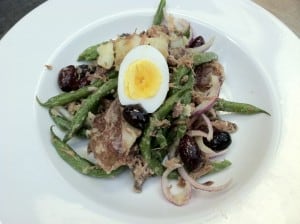Yoked

For similar reasons the neighborhood grocer used to give for living upstairs atop his store, Jeff and I live in a cottage across the street from Saxapahaw’s general store—the front shingle in clear sight—catching the strongest of the glare from the gas pumps’ nighttime awning lights and noticing, if we will, the comings and goings of folks around the village.
This vantage point affords me a most thorough experience of the general store—sometimes to my dismay, and sometimes to my great delight.
I experienced both emotions in quick succession recently when, just in the middle of a Sunday brunch service, I looked out from the north-facing windows of our house to see Alec, our talented-if-dis-tractable 23-year-old line cook, trudging upward from the field below our house. This once long-fallow cattle field is now home to Cozi Farms—a 50-acre operation that’s home to chickens, pigs, sheep, cows, a seasonal lot of turkeys, two dogs and a barn cat. The general store buys much of our chicken, some lamb and pork, and all of our kitchen eggs from this farm—and the food travels a spitting distance from field to filling station.
Alec is an intern on the farm, and at first I worried a farm emergency—or perhaps a desire for an afternoon walk—had drawn him from his duties at the stovetop. I was just preparing my slightly officious speech about separation of Farm and Store, and not leaving colleagues in the lurch, et cetera, et cetera, when into my view came the old-fashioned wire basket full of brown eggs he was toting toward the store.
As I un-squinted my eyes and reeled in my pointer finger, the reality dawned on me—Alec was bringing freshly harvested eggs from the farm to resupply the kitchen for brunch. His slightly desperate expression, not due to some escaped pig or distressed cow, was the result of having nearly run out of eggs mid-brunch on a deliciously sunny December Sunday. I mused that he must have been wondering how in the heck his cook’s job description had broadened in the last year to include harvesting the food before prepping it for service.
Mind you, this is not a normal harvest, even for us. Usually, Cozi Farms’ hands collect and prepare the eggs well in advance of brunch service, meticulously counting and crating each of the golden-yolked gifts from their flock of organically fed and pastured birds. In summer, in fact, our cooler is practically swimming in these gems, and we have to dial down other supplies to make room for them.
But since we began an exclusive kitchen egg buying arrangement with the farm, we have learned all the more that the seasonal rhythm of hen flocks means much lower egg production during the shorter days of wintertime. So now, a week past solstice, someone from the farm is often veritably loitering at the field, egg basket in hand, sweet talking the hens into our next few dozen breakfast plates.
For me, this is a joyous thing—if not a terribly efficient way, for the moment, to run a farm or a restaurant. Of course, it highlights a chief reason (other than cost) many restaurants—now that the edge of the locavore movement has been worn away by a lot of lip service—may cite local products on menus while making only token buys from actual farms. Where perfectly reasonable restaurateurs and retail specialists will tell you a complex system is your enemy, our choice to work around the likes of a chicken flock to supply a commercial kitchen with a staple item is not terribly impressive.
Hard numbers efficiency aside for the moment, I count it an economic advantage when, even if just for a moment, the lead cook—the guy who decides whether to use an egg carefully or to waste it—is also the one who had to wait while the chickens finished their daily work so he could serve our neighbors breakfast. And when our bakers can use five eggs instead of six in a cake because the quality of the egg is that much better than industrial eggs. Our customers enjoy a better meal when the colors on their plates include an impressive golden hue, instead of the dull tannish yellow I’ve come to accept from industrial layers. And it’s a cultural advantage when a staff member can holistically connect food source dots; instead of using product, he’s cooking with food.
This is to say nothing of the obvious ecological benefit of delivering our food on foot. Never mind worrying about the efficiency of small-scale transport over short distances vs. large-scale shipment over longer ones when we leave the truck in the driveway. And when we consider that this demand for production has Cozi Farms gearing up to start a second hen flock to solve our winter shortfalls by winter of 2013, we begin to see the ways in which a farm and food service partnership like ours can do more than sustain a little restaurant’s appetite for eggs—it can begin to heal our economy.
–Cameron

+ There are no comments
Add yours